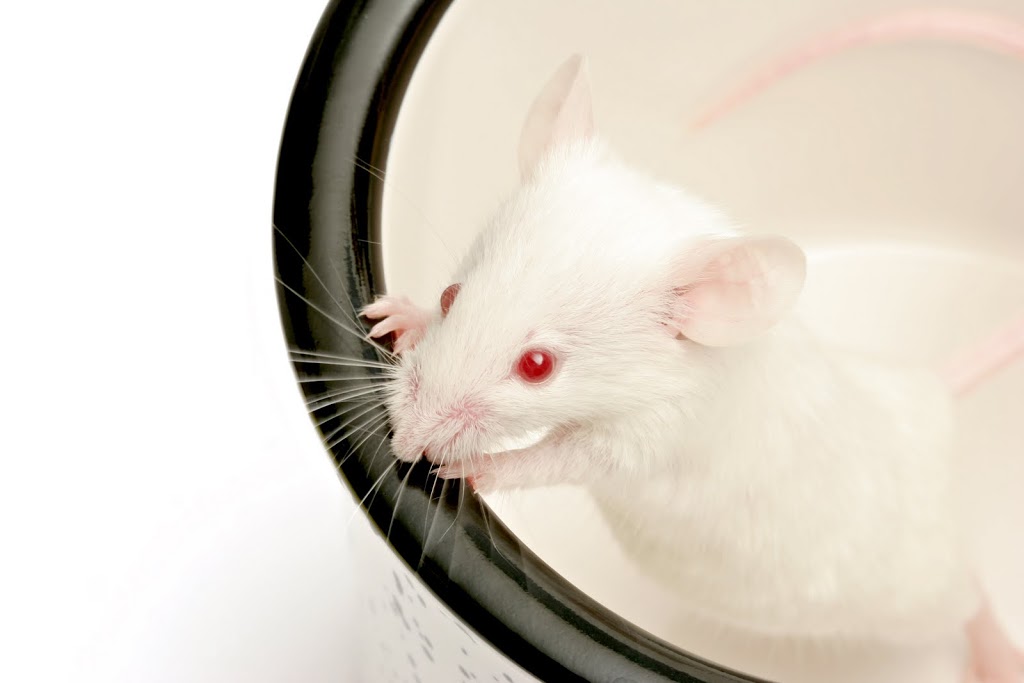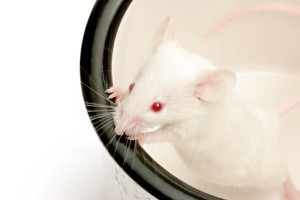
by theglamscientist | | animal testing, cosmetic testing, creulty free, FDA, raw material testing |

I’ve seen the claim “Not Tested On Animals” more times than I can count. I recently saw it while browsing Etsy, so I thought now was a perfect time to address it.
I’ll start by saying: I don’t know of any cosmetic end product that has been tested on animals. IF any exist, they are few and far between. The typical testing that cosmetic companies undergo involve test tubes, beakers, volumetric flasks, graduated cylinders, analytical instrumentation and human subjects… NOT animals.
So where does the claim come from?
The claims “Not Tested on Animals” or “Cruelty Free” are mere marketing claims meant to appeal to the consumer that opposes animal testing. Once upon a time, animal testing of cosmetics was commonly used to assess the safety of cosmetic raw materials and/or end products. Because this testing method was once widely used, many veteran cosmetic raw materials have been tested in this way. For this reason alone, the claim may not hold any weight (but it sounds good, right?).
That doesn’t mean it’s obsolete
The advancement of technology and testing methods have eliminated the need for animal testing in most instances. Even still, the FDA will support the (responsible) use of animal testing to substantiate product safety. By “responsible” I mean using as few animals as possible, as humanely as possible, while still obtaining enough information to draw a conclusion. Because animal testing is a legal and acceptable (by FDA standards) form of product testing, it may still occur today. However, it is not likely for typical end products or raw materials.
Playing Devil’s Advocate
I understand the objection to animal testing and as a cosmetic manufacturer, I do not foresee employing this strategy. HOWEVER, if a product/ingredient needed to be tested in living, fully functional skin– would you rather it get the initial trial run on an animal? or on a fellow human? Which is really more “humane”? Just food for thought.
Here’s to the Glam Life!
by theglamscientist | | FDA, fragrance, fragrance free, unscented |
With so many allergies, sensitive skin problems and the growing desire to “go green”, consumers are opting for products that don’t contain any added fragrance– or so they think. Unfortunately, there is quite a bit of ambiguity on the part of the FDA regarding appropriate wording for products that contain no added fragrance.
My twitter friend, Krissy90220, noticed that one of her personal care products was labeled “unscented” but had “fragrance” listed in the ingredients. Krissy, like most consumers felt that the label was misleading and illegal even… but, according to the FDA, this is quite alright.
There is no documented FDA definition for “unscented” or “fragrance free” which means the terms can be used freely on product labels. The FDA does, however, require that if fragrance is used in a product it be listed in the ingredients. Generally speaking, unscented is used when a product contains fragrance only to mask the chemical smell of other ingredients in the formula. Fragrance free is most often used when no fragrance exists in the formula at all. It’s not likely that leading brands will have truly fragrance free products due to the number of synthetic ingredients that are typically used. Small handmade product lines that are labeled unscented or fragrance free are more likely to be authentic. If you find a product that is labeled unscented or fragrance free, does not list fragrance in the list, but still smells scented, it is probably misbranded. Misbranding is subject to penalty by the FDA and should be reported due to the possible implications.
If you have sensitivities to fragrant chemicals and seek a product that undoubtedly contains no fragrance, the front label will not give you all the assurances you need. Always read the ingredients list on the back label of a product to be sure that what you perceive is what you will receive.
Until next time… Here’s to the glam life!
by theglamscientist | | breast cancer awareness, Cosmetic Ingredients Review, FDA, parabens, preservatives |
I think I can keep this short and sweet. In recent years there has been a big fuss made about parabens in cosmetic applications. So what’s it all about? Parabens are preservatives used to protect your personal care products from the growth of harmful microorganisms. Most personal care products have water as one of the main ingredients. Any product that contains water can grow some really nasty stuff so preservatives are a must. Sidebar– while I’m an advocate and producer of natural personal care products, I firmly believe in the use of some sort of preservative system. I do not think it is safe to sell natural products without preservatives because the average consumer does not consider expiration dates.– The most commonly used parabens are: methylparaben, propylparaben and butylparaben. They are usually used together to minimize the amount of preservatives necessary to achieve the same end result.
Parabens have been confirmed to be safe by both the FDA and the Cosmetic Ingredients Review expert panel in the concentrations used (0.01-0.3%). The problem is parabens have been found in the breast tissue of breast cancer patients. So the premise is; because parabens are in breast cancer tissue, parabens must cause breast cancer…. not necessarily true. In the studies conducted, normal breast tissue was not tested for the presence of parabens. So who knows, they may exist naturally! Parabens also exhibit estrogen like behavior. Estrogen activity has been linked to the occurance of breast cancer. However, parabens have much lower estrogen levels than what is naturally found in the human body.
Armed with this info, its now up to you to decide if you believe the hype. As a scientist, research carries a whole lot of weight to me. Personally, I am not alarmed by the ‘possibility’ of parabens causing breast cancer… but just in case, you won’t find those preservatives in my line of products.


